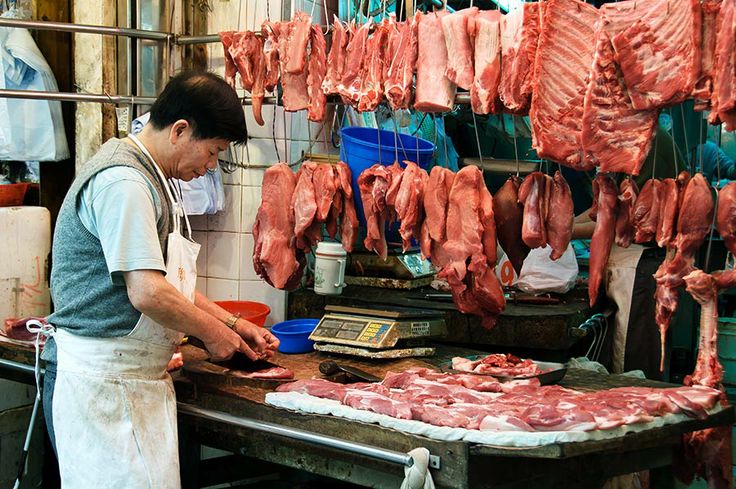China is encouraging its citizens to eat less meat — and that could be a big win for the climate

Tags: China
China is encouraging its citizens to eat less meat — and that could be a big win for the climate published by Mooba
Writer Rating: 0
Posted on 2016-05-28
Writer Description: Brandon
This writer has written 186 articles.
An updated set of dietary guidelines just released by the Chinese government could be a boon not only for public health, say some environmentalists, but also for the environment. They’re arguing that the new recommendations have the potential to reduce China’s meat consumption, or at least slow its growth, which can help save land and water resources and put a substantial dent in global greenhouse gas emissions.
The actual differences between the new guidelines and the previous ones, which were released in 2007, are slim. Both recommend an upper limit on meat and poultry consumption of 75 grams per day — but the new guidelines reduce the lower daily value from 50 grams to 40 grams. Altogether, the guidelines suggest limiting meat, poultry, fish and dairy consumption to 200 grams daily.
The real problem is that average meat consumption in China is still higher than either the old or the new guidelines recommend. According to the UN’s Food and Agriculture Organization (FAO), daily meat and dairy consumption in China still averages more than 300 grams per day — and that value is expected to keep increasing over the next few decades. The country’s meat consumption alone comes to about 62 kilograms per capita annually, while the dietary guidelines would limit it to just over 27 kilograms.
If such reductions were to actually occur, it could be a major win for the environment. Agriculture is one of the primary contributors to global greenhouse gas emissions, mostly in the form of methane and nitrous oxide — when forestry and other land use changes are factored in, the agriculture sector may account for as much as a quarter of global greenhouse gas emissions. In fact, a recent study suggested that farm emissions need to fall by a billion tons per year by the year 2030 if we’re to meet our global climate goals under the Paris Agreement.
The meat industry — and particularly beef production — is one of the biggest culprits. In addition to the huge amounts of land, water and food required to raise livestock, cattle are infamous for belching large quantities of methane into the atmosphere. And cattle raising, in particular, is known for being a major contributor to deforestation, which also drives up global carbon emissions.
Numerous studies have emphasized the environmental benefits that would come from a global reduction in meat consumption — particularly beef. Last month, for instance, the World Resources Institute released a report outlining the changes in land use and greenhouse gas emissions that would accompany a number of hypothetical global diet shifts, including reductions in the consumption of beef and animal products as a whole. And earlier this year, researchers from the University of Oxford published a paper suggesting that a more plant-based diet worldwide could cut food-related greenhouse gas emissions by anywhere from 29 to 70 percent.
The lead author of that paper, Marco Springmann of the University of Oxford, noted that such changes in China, alone, could have major health and environmental impacts. According to his research, reducing China’s average red meat consumption by about 100 grams per day in the year 2050 could help avert 2.2 million deaths and cut food-related greenhouse gas emissions by more than a billion metric tons.
“Any changes in dietary recommendations that move into that direction would represent a step in the right direction,” he told The Washington Post by email.
Additionally, an upcoming report from environmental organization WildAid estimates that adherence to the dietary guidelines could cut greenhouse gas emissions by an amount equal to 1.5 percent of total global emissions.
Whether the new guidelines can actually bring about such changes, though, is another question. Since the guidelines haven’t changed dramatically from their 2007 version — and average meat consumption has remained high (and growing) in China — it appears that more efforts may be necessary to draw consumer attention to the recommendations.
Springmann, for instance, suggested that a good step forward would be “to explicitly include the sustainability and environmental impacts of food consumption,” an approach that he said has been used in places like Brazil, Germany, Sweden and even the U.S. And, in fact, this is a strategy that WildAid is now working on in collaboration with the Chinese Nutrition Society, which prepared the new guidelines.
“WildAid was not involved in the creation of the guidelines, but we are involved in the promotion of them,” said Matt Grager, WildAid’s climate program officer. He said WildAid and the Chinese Nutrition Society have been working together to produce billboards featuring celebrities and other public figures that advertise the key messages from the new guidelines. These materials are being distributed throughout the country.
One point that’s important to remember, however, is that the meat consumption reported in China represents an average across the country. But, in fact, “there’s a big divide between consumption patterns in urban versus rural areas,” said Richard Waite, an associate in the World Resources Institute’s food program and one of the authors on the recent WRI report, by email.
“According to the China Health and Nutrition Survey, in 2011, per capita consumption of meat and dairy was nearly twice as high in urban areas as in rural areas,” he said. “So the new guidelines might still mean that some people…would actually consume more meat and dairy than they do now.”
This is not necessarily a bad thing, as malnutrition remains a problem in some areas, and the primary purpose of the dietary guidelines is to encourage citizens to eat a healthy and balanced diet. And universal adherence to the guidelines would even out in a way that would reduce the nation’s overall average meat consumption.
That said, Waite agreed that merely updating the guidelines may not be enough to spur action among consumers. “However, guidelines can be a valuable ingredient in broader efforts to shift consumption habits — by raising the profile of the issue, prompting food manufacturers to reformulate products, and prompting food service providers like cafeterias and restaurants to change what’s on their menus,” he added.
The focus on China is important, given the country’s large (and increasing) population and its current status as the world’s leading contributor to global greenhouse gas emissions. But the fact remains that average per capita meat consumption in other countries — notably, the U.S. — remains even higher. So while efforts in China are a step forward — and environmentalists remain optimistic about the changes that may come from the new guidelines and education campaign — global change in the agriculture sector will require a worldwide effort.
“What our program tries to do is communicate the benefits of climate friendly behaviors,” Grager said. “In the interest of eating healthy or eating reduced meat, the idea is that this is healthy for you and it’s healthy for the planet, so it’s a win-win situation. I would say that any country where it’s either a large population or that consumes a lot of meat, this would be a key message both for personal health and for climate change.”
Sources: https://www.washingtonpost.com/news/energy-environment/wp/2016/05/27/china-is-encouraging-its-citizens-to-eat-less-meat-and-that-could-be-a-big-win-for-the-climate/
You have the right to stay anonymous in your comments, share at your own discretion.


